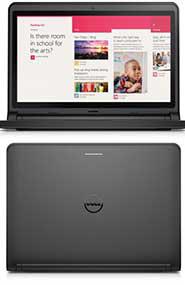Review: Dell's Latest Latitude -- A Match For Student Attitude

The design of Dell's latest Latitude laptop is a departure from its stalwart line of business laptops. And so is its intended user. The Latitude 3340 is designed for the education market, and while it has plenty of features to prove it, some won't be obvious until they're needed. It began shipping in May starting at $539 with Celeron, $669 with Intel Core i3, and comes in red, blue and black.
First and foremost, teachers are sure to find favor with the white bar near the top of the display's rear panel that lights up when airplane mode is enabled, "tattling" on kids who might be looking to sneak onto the network when they're not supposed to. And while eating and drinking are usually prohibited in classrooms, spills somehow happen anyway; a sealed keyboard and touchpad solves that problem.
The 3340's 13.3-inch LED-lit display might struggle under the bright lights of the classroom; it puts out just 200 nits. For easier screen sharing, the lid opens to a full 180 degrees. The display is surrounded by a rubberized bezel that's designed to isolate the glass and absorb shocks and bumps. There's also an option to add Gorilla Glass NBT, Corning's latest protective glass for touch-screen notebooks. A resolution of 1,366-x-768 seems a bit low-end these days, but probably more than adequate for the classroom. An external optical disc is the only option; a system recovery DVD is included.
The tested unit was delivered with Windows 8.1 Pro 64-bit with a 4-GB, single-channel 1,600MHz DDR3L memory, the unit's maximum. We also received the mid-end processor, a 4th-gen Intel Core i3-4005U dual-core CPU running at 1.7GHz and Intel HD 4400 graphics. The system had ample power and responsiveness for running test media and apps, and its power efficiency was off the charts. The 3340 delivered a peak Geekbench 2.3 score of 5343, but played media continuously with Wi-Fi on and the screen at full brightness for 10 hours and 40 minutes on a single charge. The 3340 also is available with Celeron and Core i5 processors and their accompanying graphics options.

The display attaches to the base with two large, heavy-duty hinges, between which fits the battery. The tested unit came with the larger 6-cell battery, which extends downward and tilts the back end of the keyboard up by almost half an inch. The unit measures a compact 13 inches wide by 9.6 inches deep by 1 inch thick at the front and 1.4 inches at the rear. The 4-cell battery keeps the unit at a flat 1 inch all around. The plastic wrist rests feel comfortable enough, but the touchpad is smallish at 3.4 inches-by-2 inches. The unit weighs less than 4 pounds with either battery.
The left edge is home from front to rear to an always-powered USB 3.0 port, mini DisplayPort, HDMI port, heat exhaust vent, gigabit Ethernet and power input. There are no powers on the rear edge. Working around to the right edge, we find a Kensington lock port, the other USB 3.0 port, headset port and SD card reader. The right side also finds the system's power, network, battery and hard drive LEDs, which are visible with the lid open or closed. Also standard is the Wi-Fi AC emerging high-speed standard and Bluetooth 4.0; support for Intel's Wireless Display (Wi-Di) protocol is an option. The keyboard is not backlit, but does have a toggle for enabling one-finger function key operation.
The Latitude 3340 can be managed with Microsoft System Center, Dell's own KACE management appliances or other industry-standard tools. For its low starting prices, durability and long battery life between charges, the CRN Test Center recommends the Latitude 3340 for resellers targeting K-12 education markets. And thanks to some unique features for the education market, it's a laptop that will help keep students from surfing when they should be turfing.
PUBLISHED MAY 13, 2014